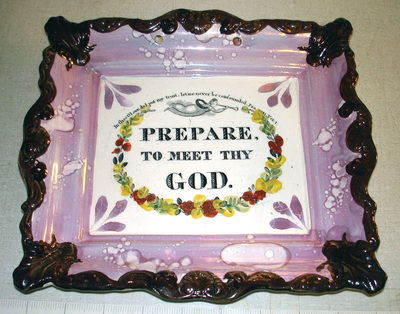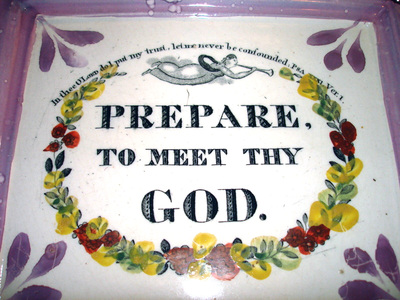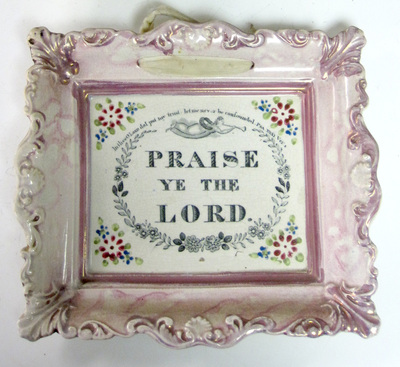|
In my previous post I wrote about the attribution of a group of transfers - which appear on pink-lustre items c1845-55 - to Newbottle High Pottery. I've found no record yet of pink-lustre items having been made at that pottery, so the attribution raises all sorts of questions. Was the pottery large enough to have produced all the items with the group 2 transfers? It would have required a reasonable number of potters, printers and painters. What event in the 1850s caused the transfer plates to move from Newbottle to Moore's? What were the links between those Sunderland potteries? Why did Newbottle stop making pink-lustre items and revert to making brown ware and flower pots as described in Baker? Firstly, click here to see the limited group of items donated to the V&A, by W H Fairbairns, 'grandson of the owner of Newbottle High pottery'. Not an item of pink lustre among them. Baker states that, almost a century before, the Austin, Moore, Scott and Dixon families had lived around Newbottle and trained as potters at the firm of Byers and Co, Newbottle. Anthony Scott appears to have managed that pottery for a period up until 1788, before setting up his own business in Southwick. Robert Fairbairns then ran the pottery until sometime after c1841. So the items in the V&A all likely predate the 1840s, and perhaps pink lustre wasn't being produced at Newbottle during that period. Sometime between 1841 and 1851 the pottery was taken over by John Brodrick and James Beckworth (Baker). I'm indebted to Norman Lowe who has looked up census records from around that time. He writes: The number of people apparently working in the pottery industry in Newbottle were: 1841, 29; 1851, 40; and 1861, 31. So it seems that the Newbottle potteries were more active in 1851 than either before or afterwards. Of these, 7 people were there throughout including James Beckwith. There were no members of the Brodrick family there in 1841, and also no members of the Fairbairns family at any time in the period. This fits with our narrative, that between c1845-55 Newbottle stepped up its production and had the capacity to make a significant body of lustre pottery. It also suggests that by then the Fairbairns family had ceased involvement with the pottery, and gives us a face-value explanation for why lustre items from that period don't form part of the gift to the V&A. Baker states the number of people employed by Beckwith and Brodrick in 1851 as 46: 22 men, 13 women and 11 boys. Norman further writes that: In 1851 a pottery (apparently the “High” pottery) was clearly owned by John Brodrick and James Beckwith. It would seem to have been a fairly significant concern as there was one pottery painter, 6 printers, a platemaker, 3 turners, a cutter, and 22 general workers. There was also Thomas Swailes, an earthenware dealer, so they presumably had their own salesman. By 1856 the partnership seems to have terminated and in 1861 Beckwith had retired, Brodrick had disappeared, presumably died, but John Beckwith, son of James, 30 is still listed as a potter. Baker indicates that this development was mainly for brown ware and closed down before 1878. So my view is that, up to 1851 at least, a Newbottle pottery, owned by Brodrick and Beckwith, was a going concern with printers and a painter. Perhaps, then, the sale of transfers to [Moore's] was after they split up sometime in the mid-1850s. Again this dovetails with the attribution of a large number of transfer-printed lustre items to Newbottle c1845-55. What's more, Norman provides a credible reason for the transfer plates moving to Moore's in the mid 1850s. The pottery, perhaps finding it hard to compete with its larger Sunderland neighbours - Dixon's, Moore's and Scott's - decided to focus on producing less labour-intensive items. Norman further adds that in 1841: The total number of people working in pottery in Sunderland including Newbottle was 282, so the 29 at Newbottle was 10% of the total. We know that there were 30 at North Hylton, so that leaves 223 for the remainder, Garrison, Dawson, Moore and Scott (ignoring any others), an average of 56 each. In other words Newbottle and North Hylton were each just over half the size of the “major” potteries. By 1851 we’ve lost North Hylton but the 40 at Newbottle is still 10% of the 395 for Sunderland as a whole. None of this proves that Newbottle High Pottery made the pink-lustre items with the group 2 transfers. It does, however, suggest that it was possible for the pottery to have produced plaques in those kind of numbers. We're trying to get hold of a copy of Andrew Fletcher's 'Potteries of Newbottle' (2005), which might further help. If you have one, or know the author, please get in touch. P.S.Two items of interest have come up since I wrote my last post. Firstly, a brown-bordered plaque with the 'plate 3' Prepare transfer. So it appears that the transfer plate did make it to Moore's after all, but was very rarely used by that pottery. Secondly, a Newbottle-attributed plaque with the 'plate 3' Praise Ye transfer came up at auction this week. Unusually, it is of the larger-sized plaque mould, on which Richard Cobden appears, and has the flower decoration around the transfer that appears to be specific to Newbottle.
0 Comments
Leave a Reply. |
AuthorStephen Smith lives in London, and is always happy to hear from other collectors. If you have an interesting collection of plaques, and are based in the UK, he will photograph them for you. Free advice given regarding selling and dispersal of a collection, or to those wishing to start one. Just get in touch... Archives
February 2022
AcknowledgementsThis website is indebted to collectors, dealers and enthusiasts who have shared their knowledge or photos. In particular: Ian Holmes, Stephen Duckworth, Dick Henrywood, Norman Lowe, Keith Lovell, Donald H Ryan, Harold Crowder, Jack and Joyce Cockerill, Myrna Schkolne, Elinor Penna, Ian Sharp, Shauna Gregg at the Sunderland Museum, Keith Bell, Martyn Edgell, and Liz Denton.
|


